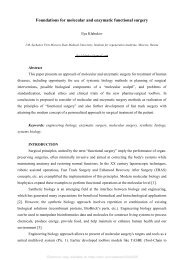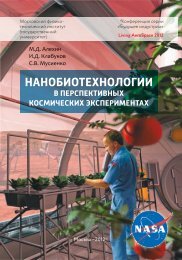Engineering Biology Problems Book (2021, Obninsk Edition)
You also want an ePaper? Increase the reach of your titles
YUMPU automatically turns print PDFs into web optimized ePapers that Google loves.
[2. Schuergers, N., Werlang, C., Ajo-Franklin, C., & Boghossian, A. (2017). A Synthetic Biology
Approach to Engineering Living Photovoltaics. Energy & Environmental Science.
doi:10.1039/C7EE00282C]
Figure 1.2 Schematic diagram of the implementation of a solar cell based on cyanobacteria [3].
Abbreviations: EET (excitation-energy transfer) - energy transfer (electronic) excitation.
[3. Szczupak, A., Halámek, J., Halámková, L., Bocharova, V., Alfonta, L., & Katz, E. (2012). Living
battery–biofuel cells operating in vivo in clams. Energy & Environmental Science, 5(10), 8891-8895.
doi:10.1039/C2EE21626D]
1.7. The Mushroom Smart Grid. Using a palette of additional symbiotes you have been able to
deploy a living solar array over a vast expanse of Arctic swamps. The problem now, however, is the
preservation of the hard-earned electricity. For various reasons, primarily the consequence of high
humidity and a sharply continental climate, the use of existing batteries is impossible. However, there
are mechanisms in nature that allow electricity to be stored (e.g. muscle-like cells in the body of an
electric stingray). Propose a design capable of harvesting electricity and delivering 10 kW of constant
power.
SOLUTION:
This problem proposes to implement a complex system consisting of a variable input power
accumulator and an output voltage source (DC) with physical current limitations.
To date, there are ideas of building accumulators from living cells, such as cell cultures of mollusks
(Fig. 1.3) [4]. In our opinion, however, the realization of large-scale "living batteries" can be
implemented in plant macro-objects, such as a growing fungus.
[4. Szczupak, A., Halámek, J., Halámková, L., Bocharova, V., Alfonta, L., & Katz, E. (2012). Living
battery–biofuel cells operating in vivo in clams. Energy & Environmental Science, 5(10), 8891-8895.
doi:10.1039/C2EE21626D]
Figure 1.3. (A) Photo of a clam with implanted biocatalytic electrodes. (B) Schematic of the connected
external variable load to the battery with biofuel, to measure the voltage and current produced under
in vivo conditions. (C) Charging performance of a












